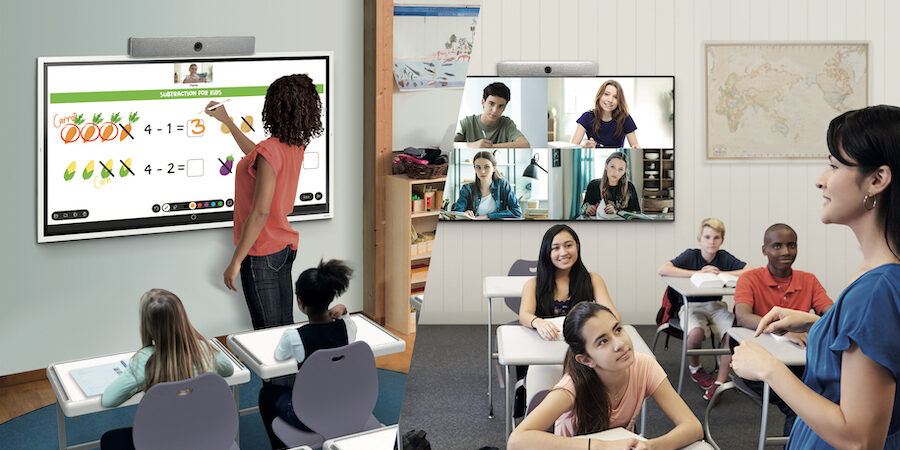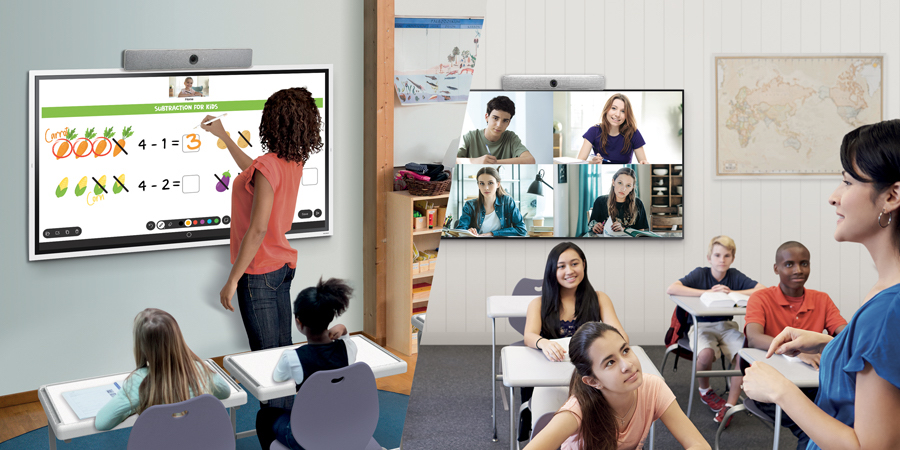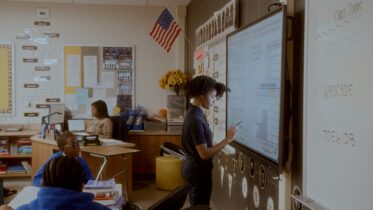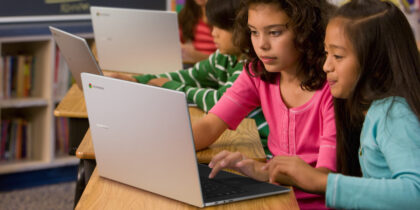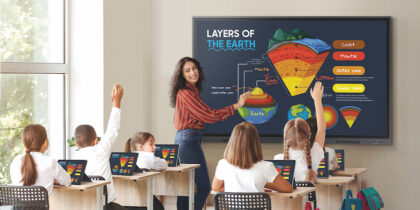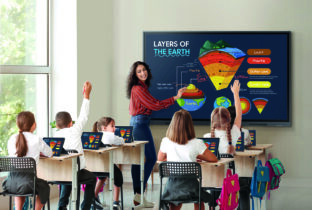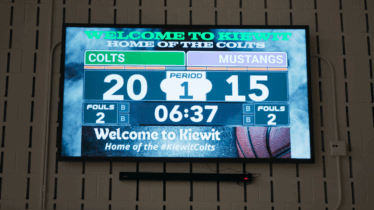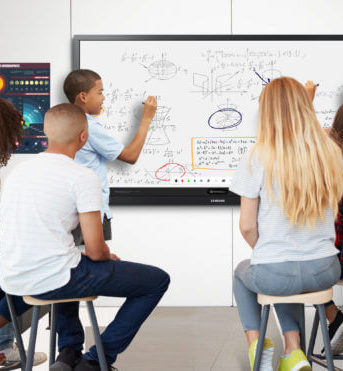Elementary schools, middle schools and high schools — not to mention college campuses — are moving to a connected campus model. From outdoor digital signage for schools to cafeteria signage to classroom interactive whiteboards, these powerful tools help educators teach, engage, inform, guide, promote and celebrate students.
Indeed, flat-panel monitors and interactive displays are now common for classroom teachers, and they’re growing in popularity across campuses as attention-grabbing communication tools to inform educators, administrators, students and parents alike. With their ability to support a hybrid learning environment, interactive displays are even more important in today’s educational setting, which incorporates both in-person and hybrid learning.
Digital signage technology has dozens of uses in education. These eight applications are some of the most popular for displays in classrooms and on campuses:
1. Collaboration hub
Most students have used a chalkboard or dry-erase board to brainstorm, and they know the frustration of having their work erased before someone has transcribed it or taken a photo. The Samsung Interactive Display, available in 65-and 75-inch models, comes with built-in annotation tools that can preserve notes and share them easily. Educators and students can open documents, take notes and then save, archive, retrieve or email them — right from the screen.
Allowing for active collaboration, the Samsung Interactive Display offers a user-friendly, whiteboard-like surface that can function as a digital display. The screen features a smooth, pen-to-paper writing experience with multiple input capability, so up to 20 students can write on it at the same time.
AirClass, a pre-installed app on the Samsung Interactive Display, is a tool that works with physical, virtual and hybrid instruction and is incredibly helpful for formative assessment strategies for in-the-moment student check-ins. It allows teachers to engage in-class or remote learners in lessons and surveys. It can also display answer distribution from users, show who is the first to answer a question and randomly select students to respond to a prompt.
Because the interactive whiteboard connects seamlessly to videoconferencing solutions, remote learners can feel like they’re in the classroom even when learning from a remote location, be it at home or another classroom within the school or district. The intuitive technology and Android OS make it particularly easy to do so.
2. Creativity central
Along with its smooth writing functionality, interactive whiteboards allow students to create digital works of art, with brushstroke modes that support watercolor and oil painting styles. Thanks to the embedded InGlass technology in the Samsung Interactive Display, students can draw without any lag. Their work can be easily archived and retrieved on the school network, and it can be emailed or saved to USB. The display is simple enough to use so even preschoolers can use them for fun and instructional activities. Interactive displays can also help educators boost social and emotional learning (SEL) by supporting SEL-related games, videos and choice boards.
3. Healthy eating
Digital menu boards are now common in quick-service restaurants, and the same benefits can apply to school cafeterias. These digital menus quickly, accurately and cost-effectively convey food options at order counters. Common areas where students have lunch are ideal places to relay the cafeteria’s food options and daily specials. The digital menus can also display nutrition tips that promote healthy eating choices.
4. On-campus announcements
Outdoor LED signage on your school’s marquee can communicate upcoming events or other campus-wide news to parents and students as they arrive or leave campus. In lobbies, hallways and other gathering points on campus, wall- and ceiling-mounted, flat-panel displays can easily reach the entire school population. That’s because students are more likely to miss — or ignore — announcements, reminders and other key information when they’re delivered via traditional tools, such as an intercom.
Blended learning without limits
Simple, scalable and secure display solutions empower educators to take control of curriculum. Download Now
Digital displays’ messaging can be relayed prominently and repeatedly, reminding students, staff members and parents of forms that need to be completed and returned, promoting an upcoming school event or celebrating a team’s state championship.
Outside, high-brightness displays allow larger campuses with many buildings to communicate announcements to visitors or deliver wayfinding that guides them to the appropriate room. These screens are purpose-built to always be legible and vibrant, even on the sunniest, most glare-filled days. They also have the engineering to work reliably in extreme weather — even baking hot, freezing cold, drenching rain and tree-bending winds.
5. Automated alerts
Paired with management software, digital signage displays operating on a school’s network can be preconfigured to share alert messaging based on real-time data from internal or external systems. In partnership with education-focused IT services firm HAVRION, Samsung interconnects school building safety systems and sensors. If, for instance, a carbon monoxide detector goes off, it automatically sends a predesigned alert message to on-campus screens, letting everyone know the safety protocol.
6. Streaming videos
Many schools are replacing their existing TVs and cable boxes with smart signage monitors that support IPTV and video streaming. In hybrid and blended learning arrangements, classroom screens can include remote students’ video streams, allowing for full-fledged two-way interaction and engagement. In common areas, streaming-ready screens can share everything from remote lectures and overflow views of a sold-out school event to a live news feed.
7. Hybrid learning
Facilitating an engaging, interactive classroom is uniquely challenging, especially on college campuses where there are hybrid learners or students who are attending classes virtually. By using a webcam monitor with built-in speakers, such as the S40VA webcam monitor, educators can reach those students who are learning remotely. A 178-degree viewing angle paired with crisp, clear video and audio ensures teachers can see and hear all their students so everyone can focus on the lesson rather than troubleshooting technology issues.
8. Assistive technology
More than 7 million students are diagnosed with disabilities, including learning and attention disorders, and 5 million are learning English as a second language. Smart boards such as Samsung Interactive Display make it easier for educators to teach everyone in the classroom, regardless of abilities and needs. In fact, smart boards are fast becoming a frequently used assistive technology in the classroom.
Not sure which display best suits your education needs and your budget? Browse the full lineup of Samsung displays, and learn more about how they can transform a classroom.
